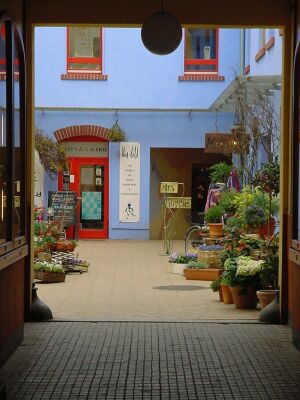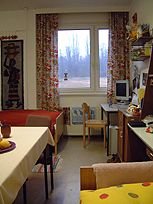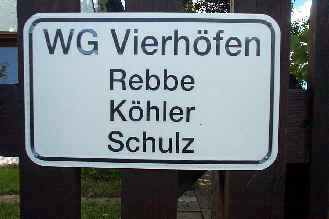12.18 Housing in Germany
 Inside and outside Inside and outside
German houses and flats show a number of differences from English dwellings. For one thing, many (particularly old) German flats are located in courtyards (der Hof) (see picture left) that lie back from the main road. When reading accommodation adverts for such buildings, you must note whether the flat is located in the building that faces the road (das Vorderhaus), the building behind the courtyard (das Hinterhaus) or in one of the side wings of the building (der Seitenflügel). A large number of residences also have roll-down shutters (der Rollladen) (note the three l's in the middle of the word!) outside the windows which provide added security and also serve to insulate the property.
The British fixation with wall-to-wall carpeting is not replicated in Germany. Instead parquet flooring (das Parkett; der Parkettboden) is much more common, as are wooden floors. In keeping with the Germans' pronounced environmental awareness, energy-saving measures are widely-used. Thus a number of residences employ under-floor heating and have a high standard of insulation. You may well see buildings (and even bus-stops!) with solar panels on their roof in an attempt to harness solar energy (die Solarenergie).
And a major difference that you cannot "see" but definitely need to be aware of is the difference in voltage between Britain and Germany. All electrical power points in Germany are designed for 220 volts, 50 Hz. AC and two-point plugs. Any adapters you may need can be bought in electrical shops either in Britain or in Germany.
 To rent or to own? To rent or to own?
It is still largely the case that an Englishman's home is his castle: 60% of British people live in their own house or flat, which is only a slightly lower percentage than in the United States (64%). In Germany however, the majority of people live in rented accommodation, with only 39% living in their own house or flat. There are a number of reasons for this. With house prices remaining high, renting is often a cheaper option and one that offers greater flexibility. It can also be quite complicated to obtain a mortgage (die Hypothek) in Germany.
Furnished flats are as a rule not as common as they are in Britain, and remember that unfurnished in Germany really does mean unfurnished. You'll invariably have to supply your own lights, lighting fixtures, tables, chairs, cooker etc. And furnished flats are much more expensive than unfurnished accommodation.
The German housing market is also different in that a much higher percentage of Germans live in flats (die Wohnung) and appartments (das Appartement) than their British counterparts. These can either be flats that they own (die Eigentumswohnung) or more commonly rented flats (die Mietwohnung).
The housing market is changing quite quickly however. Both in the countryside and in towns and cities, Germans are buying plots of land (das Grundstück) and have their own house built on it. This explains why a single German street may have detached houses (das Einfamilienhaus) with a wide diversity of designs. Semi-detached houses (das Doppelhaus; das Zweifamilienhaus) are less common in German-speaking countries than in Britain but there has recently been an increase in the number of terraced houses (das Reihenhaus).
Shared accommodation
Many young people choose to live in shared flats or houses - "die WG" which is short for "eine Wohngemeinschaft" (literally: "a living community"). This means that two or more flatmates share an apartment including a communal kitchen and bathroom. It is standard practice for the existing flatmates to choose the new inhabitant themselves, so a lot of vacancies are filled by word of mouth.
"WGs" (note the plural!) are particularly popular with students as they provide a relatively cheap option to halls of residence where space is in any case strictly limited (see next page).
 |
| A sign on a German WG |
|
Der Wohnberechtigungsschein (WBS)
The "Wohnberechtigungsschein (WBS)" is a permit for subsidised housing issued by a town, city or community to any single person earning less than 12,000 euros per year or a couple earning less than 18,000 euros per year. The WBS permit is valid for one year and entitles the recipient to rent subsidised housing at a rent well below average for the free housing market. You can apply for a WBS permit at the local housing authority (Amt für Wohnungswesen).
 Chapter 12.19: Student accommodation Chapter 12.19: Student accommodation

 Print This Page Print This Page
|